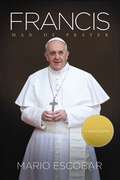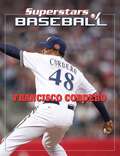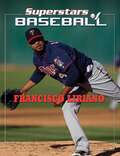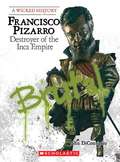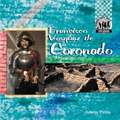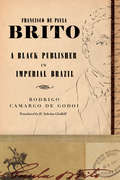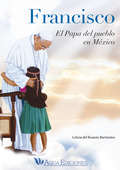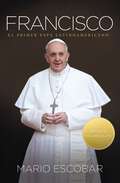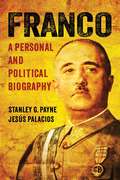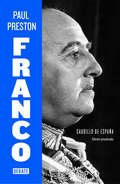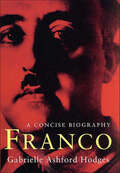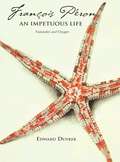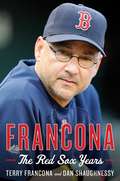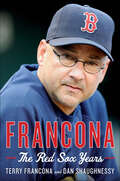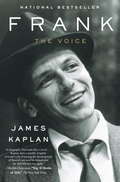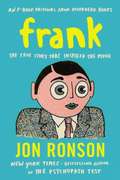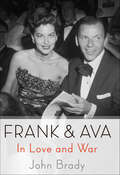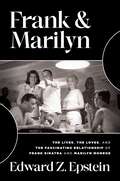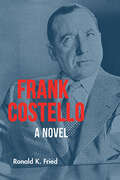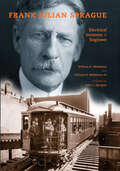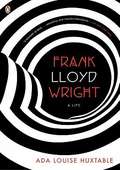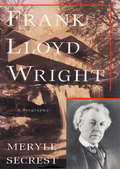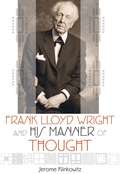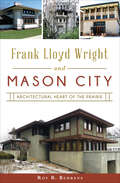- Table View
- List View
Francis: Man of Prayer
by Mario EscobarFirst Jesuit. First Latin American. And a new pope who chose as his first act a simple request: please pray for me.The recent resignation of Pope Benedict XVI took the world by surprise and for good reason. More than 600 years had passed since a pope last left his post.Jorge Mario Bergoglio, now Pope Francis, is a man of prayer, a man of action, and a humble man who has always promoted others over himself. In fact, it was Bergoglio who bowed out of the running in the papal election of 2005 to facilitate the rise of Benedict XVI.However, the new pope faces a Catholic Church in crisis--a church that has lost the media pull of John Paul II and is still hounded by pedophile scandals and the filtration of documents from former papal administrations. His first year may not be an easy one, but neither this man nor the church itself has ever shied away from the challenges thrust upon them.Pope Francis is austere and simple but has vast theological training. He is a man of his time but one who also travels by subway and bus just like any other citizen. Tirelessly fighting poverty and marginalization, he is a beacon of hope for the poor, persecuted sectors of the church. Has a Catholic spring finally arrived after a very long winter?Francis is the complete biography of a humble man who has suddenly become one of the most powerful and influential men on the planet.
Franciscan Saint of the Day
by Patrick MccloskeyThis book introduces the saints of the Franciscan Calendar, men and women who make up the "multitude" of the Francisan family which spans the 800 years from Francis's birth to our own day. Each entry consists of a brief biographical sketch, a quote either from the person or about the person, and a comment on some aspect of the person's life particularly relevant to a follower of Francis today. Saints and blessed are listed on the days indicated by the Franciscan calendar.
Francisco Cordero (Superstars of Baseball)
by Tania RodriguezFrancisco Cordero--or "Coco", as his fans and teammates know him--is a top-notch pitcher. He strikes out batters with his fastballs and sliders. He's racked up a lot of saves over the years as a closing pitcher for teams like the Rangers, the Brewers, and the Reds. Although when Cordero was a child, his family struggled with poverty, Cordero now does his part to help others who are struggling. He's a Big League player with character!
Francisco Liriano (Superstars of Baseball)
by Tania RodriguezFrancisco Liriano is a powerful Major League pitcher. Fans have watched him overcome injury after injury. He always comes back! His amazing stats and strong pitching arm have earned him awards, as well as millions of dollars. Ever since he was a young baseball player in the Dominican Republic, Liriano has been one of a kind. Find out more about his road to the Big Leagues--and discover what it takes to be a baseball superstar!
Francisco Pizarro: Destroyer of the Inca Empire
by John DiconsiglioBiography of Francisco Pizarro and his effects on the Inca Empire, for teens.
Francisco Vasquez de Coronado
by Kristin PetrieThis text traces the life of Francisco Vasquez de Coronado, who led a major expedition from Mexico through what is now the southwestern United States.
Francisco de Paula Brito: A Black Publisher in Imperial Brazil
by Rodrigo Camargo GodoiFrancisco de Paula Brito is a biography of a merchant, printer, bookseller, and publisher who lived in Rio de Janeiro from his birth in 1809 until his death in 1861. That period was key to the history of Brazil, because it coincided with the relocation of the Portuguese Court from Lisbon to Rio de Janeiro (1808); the dawning of Brazilian Independence (1822) and the formation of the nation-state; the development of the press and of Brazilian literature; the expansion and elimination of the trans-Atlantic slave trade; and the growth of Rio de Janeiro&’s population and the coffee economy. Nevertheless, although it covers five generations of Paula Brito&’s family—men and women who left slavery in the eighteenth century—this book focuses on its protagonist&’s activities between the 1830s and 1850s. During that period, Francisco de Paula Brito became one of the central figures in the cultural and political scene in the Imperial capital, particularly through his work as a publisher. Paula Brito&’s success was due in part to his ability to forge solid alliances with the Empire&’s ruling elite—among them leading politicians responsible for the unification of the vast Brazilian territory and for the maintenance of slavery and the illegal trafficking of Africans. Consequently, through the books and newspapers he published, Francisco de Paula Brito became part of a much larger project.
Francisco el Papa del pueblo
by Leticia del Rosario BarrientosEl Papa Francisco, es símbolo de la pobreza, la humildad, la sencillez y la reconstrucción de la Iglesia Católica. Desde su nombramiento ha venido rompiendo esquemas del vaticano, manejándose con una austeridad absoluta, sorprendiendo al mundo entero con su doctrina incluyente hacia todas las religiones. En este libro encontrará una semblanza anecdótica del Papa que nos ayuda a comprender el porqué de su actuar y sus sentimientos. También incluye una selección de sus frases más personales, datos relevantes de los viajes que ha realizado y resúmenes de sus encíclicas.
Francisco: El primer papa latinoamericano
by Mario EscobarEl Primer Papa Latinoamericano. Un hombre que eligió como su primer acto una simple petición: por favor oren por mí.Francisco es la biografía completa de un hombre humilde que de la noche a la mañana se ha convertido en uno de los hombres más influyentes del planeta.La reciente dimisión del Papa Benedicto XVI tomó al mundo por sorpresa y por buenas razones. Más de 600 años han pasado desde que un Papa renunció a su cargo.Jorge Mario Bergoglio, ahora Papa Francisco, es un hombre de oración, un hombre de acción y un hombre humilde que siempre ha promovido a otros sobre sí mismo. El fue quien en 2005 renunció al papado, para facilitar el ascenso de Benedicto XVI.Sin embargo, el nuevo Papa enfrenta a una iglesia católica en crisis --una iglesia que ha perdido la atracción de los medios de comunicación de Juan Pablo II y es acosada por los escándalos de pedofilia. Su primer año puede no ser fácil, pero ni este hombre ni la Iglesia han eludido los retos que se les han impuesto.El Papa Francisco es un hombre sencillo pero con una amplia formación teológica. Es un hombre de su tiempo, pero uno que también viaja en metro y autobús al igual que cualquier otro ciudadano. ¿Ha llegado por fin la primavera después de este invierno tan largo?El primer papa latinoamericano es una completa biografía de un hombre humilde que repentinamente se ha convertido en uno de los hombres más poderosos e influyentes del planeta.
Franco
by Stanley G. Payne Jesús PalaciosThe history of modern Spain is dominated by the figure of Francisco Franco, who presided over one of the longest authoritarian regimes of the twentieth century. Between 1936 and the end of the regime in 1975, Franco's Spain passed through several distinct phases of political, institutional, and economic development, moving from the original semi-fascist regime of 1936-45 to become the Catholic corporatist "organic democracy" under the monarchy from 1945 to 1957. Distinguished historian Stanley G. Payne offers deep insight into the career of this complex and formidable figure and the enormous changes that shaped Spanish history during his regime.
Franco (edición actualizada): Caudillo de España
by Paul PrestonLa publicación de esta edición revisada y actualizada de la biografía de Franco de Paul Preston, a los cuarenta años de la muerte del dictador, es un acontecimiento, no en vano sigue siendo considerada unánimemente como la obra de referencia. Contra la visión de Franco como figura providencial, una biografía completísima, rigurosa y apasionante del hombre que rigió España durante tantos años, donde se muestra al militar ambicioso e implacable, al admirador de Hitler y Mussolini; al dirigente político cada vez más pagado de su propio papel, pero incapaz de comprender la complejidad de Estado y la economía modernas. Queda el hombre visceralmente conservador, tan cauto como ambicioso, hábil en el manejo de las personas y de los contrapesos del poder. Un libro imprescindible para quien quiera comprender la historia reciente de España, así como a uno de los personajes centrales de la misma. La crítica ha dicho...«Paul Preston ha escrito, y con gran diferencia, la mejor biografía del dictador Franco.»L.M. Anson «La biografía definitiva y apasionante del dictador español Francisco Franco.»Publishers Weekly «Preston nos presenta un retrato de Franco muy diferente al que generalmente conocemos.»Kirkus Review
Franco: A Concise Biography
by Gabrielle Ashford HodgesGeneral Francisco Franco came to prominence during the days of David Lloyd George and Woodrow Wilson and was able to cling to absolute political power until his death in 1975. Over his fifty-year career, he became one of the four dictators who changed the face of Europe during the twentieth century.Franco joined the Spanish Army when he was barely fifteen years old. In 1926 he became the youngest general in Europe and, driven by an astonishing sense of his own greatness, was recognized as sole military commander of the Nationalist zone during the Spanish Civil War. His ambition was always to hold on to the power that he had secured. In practice, this meant winning the Spanish Civil War and surviving the fall of the fascist regimes of Hitler and Mussolini and the international isolation that followed their defeat.But behind the military heroics and dexterous political footwork lay an insecure and vengeful man, wracked by contradictory impulses. Although fueled by a single-minded determination to succeed, he was full of self-doubt. A bold and sometimes inspirational soldier in Africa, he became an indecisive, hesitant military commander during the Civil War. Filled with a burning conviction that his destiny was bound up with the medieval kings of Spain and God Himself, he appeared shy, withdrawn, and humble. Ruthlessly intent on wiping out all political opposition, he denied heatedly that he was a dictator. A stubborn man, he could be remarkably flexible when it came to safeguarding his power.Gabrielle Ashford Hodges' psychological biography considers Franco's mental state, as well as his political motivation. In doing so, it succeeds admirably in getting under the skin of Europe's most enduring dictator.
Francois Peron: An Impetuous Life
by Edward DuykerIn 1800 François Péron, an ambitious young medical student not long released from the French revolutionary army, gained a place as an assistant zoologist on Nicolas Baudin's expedition to Australian waters. As his colleagues either deserted or died, he would rise rapidly within the expedition's ranks and even write its official account. In doing so, Péron would seek to destroy Baudin's posthumous reputation. The expedition was famously marked by the vexed relationship between Péron and Baudin, but Péron's work, as a man of science, profoundly enhanced the achievements of the expedition: he seized valuable opportunities to pioneer zoological, oceanographic and ethnographic studies, and as an ecological observer was remarkably prescient. Edward Duyker's meticulously researched biography of Péron takes readers on an engaging and wide-ranging journey—from the heart of pre-revolutionary rural France, to the bitter fighting on the Rhineland front in 1793-94, to the late eighteenth-century Paris medical school, to landfalls in the Atlantic and the Indian Oceans, to the little-known shores of Van Diemen's Land and New Holland, and back into the very heart of Napoleon's Empire. This is both a balanced assessment of the difficult relationship between Péron and Baudin, and an analysis of the conduct of science during some of the most turbulent years in French history.
Francona: The Red Sox Years
by Dan Shaughnessy Terry FranconaFrom 2004 to 2011, Terry Francona managed the Boston Red Sox, perhaps the most scrutinized team in all of sports. During that time, every home game was a sellout. Every play, call, word, gesture--on the field and off--was analyzed by thousands. And every decision was either genius, or disastrous. In those eight years, the Red Sox were transformed from a cursed franchise to one of the most successful and profitable in baseball history--only to fall back to last place as soon as Francona was gone. Now, in Francona: The Red Sox Years, the decorated manager opens up for the first time about his tenure in Boston, unspooling the narrative of how this world-class organization reached such incredible highs and dipped to equally incredible lows. But through it all, there was always baseball, that beautiful game of which Francona never lost sight. As no book has ever quite done before, Francona escorts readers into the rarefied world of a twenty-first-century clubhouse, revealing the mercurial dynamic of the national pastime from the inside out. From his unique vantage point, Francona chronicles an epic era, from 2004, his first year as the Sox skipper, when they won their first championship in 86 years, through another win in 2007, to the controversial September collapse just four years later. He recounts the tightrope walk of managing unpredictable personalities such as Pedro Martinez and Manny Ramirez and working with Theo Epstein, the general managing phenom, and his statistics-driven executives. It was a job that meant balancing their voluminous data with the emotions of a 25-man roster. It was a job that also meant trying to meet the expectations of three owners with often wildly differing opinions. Along the way, readers are treated to never-before-told stories about their favorite players, moments, losses, and wins. Ultimately, when for the Red Sox it became less about winning and more about making money, Francona contends they lost their way. But it was an unforgettable, endlessly entertaining, and instructive time in baseball history, one that is documented and celebrated in Francona, a book that examines like no other the art of managing in today's game.
Francona: The Red Sox Years
by Dan Shaughnessy Terry FranconaTHE NEW YORK TIMES BESTSELLER. “Eloquent and dazzling,” the story of the legendary baseball manager’s tenure with the Boston Red Sox (Philadelphia Daily News).When Terry Francona took over as manager of the Boston Red Sox in 2004, the storied franchise hadn’t won a World Series championship in eighty-six years. Led by Francona, the team won two over the course of four years. During the full eight years of Francona’s tenure, the Red Sox were transformed from “cursed” into one of the most successful and profitable teams in baseball history—only to fall back to last place as soon as Francona was gone.Francona: The Red SoxYears lets readers in on the inner workings of the Red Sox clubhouse like no book has ever done before. From the highs of the World Series to the lows of the final months of the 2011 season—the most epic collapse of a team in baseball history—this book features the never-before-told stories about Sox fans’ favorite players, moments, wins, and losses.“A scorched-earth memoir . . . [that] touches fleetingly on steroid use, sabermetrics, and Michael Jordan’s stint in the minor leagues . . . but saves its heaviest artillery for the owners . . . [and] Theo Epstein backs him up.” —The New York Times Book Review“It’s not often that baseball aficionados and gossip gluttons can plunk down on a shared portion of outfield grass with the same book for an afternoon of readerly delight, but Francona can bridge those kinds of differences.” —The Boston Globe
Frank
by James KaplanBestselling author James Kaplan redefines Frank Sinatra in a triumphant new biography that includes many rarely seen photographs. Frank Sinatra was the best-known entertainer of the twentieth century--infinitely charismatic, lionized and notorious in equal measure. But despite his mammoth fame, Sinatra the man has remained an enigma. As Bob Spitz did with the Beatles, Tina Brown for Diana, and Peter Guralnick for Elvis, James Kaplan goes behind the legend and hype to bring alive a force that changed popular culture in fundamental ways. Sinatra endowed the songs he sang with the explosive conflict of his own personality. He also made the very act of listening to pop music a more personal experience than it had ever been. In Frank: The Voice, Kaplan reveals how he did it, bringing deeper insight than ever before to the complex psyche and turbulent life behind that incomparable vocal instrument. We relive the years 1915 to 1954 in glistening detail, experiencing as if for the first time Sinatra's journey from the streets of Hoboken, his fall from the apex of celebrity, and his Oscar-winning return in From Here to Eternity. Here at last is the biographer who makes the reader feel what it was really like to be Frank Sinatra--as man, as musician, as tortured genius.From the Hardcover edition.
Frank
by Jon RonsonFrom the bestselling author of The Psychopath Test comes a characteristically humorous story of a musician on the margins. In Frank: The True Story that Inspired the Movie, Jon Ronson reflects on his days playing keyboard for the Frank Sidebottom Oh Blimey Big Band. Frank Sidebottom, best known for performing with a big fake head with a cartoon face painted on it, was a cult favorite in the United Kingdom and is the subject of the new movie Frank, co-written by Ronson and starring Michael Fassbender, Maggie Gyllenhaal, and Domhnall Gleeson.
Frank & Ava: In Love and War
by John Brady"If I had to go back in Hollywood history and name two people who were most desperately and passionately in love with each other, I would say Frank Sinatra and Ava Gardner were It" —Liz SmithIt began in Hollywood's golden age when Ava was emerging as a movie star. But she fell in (and out of) love too easily. Mickey Rooney married her because he wanted another conquest. Artie Shaw treated her like a dumb brunette, giving her a reading list on their honeymoon. Neither marriage lasted a year. Then, after being courted by Howard Hughes and numerous others, along came Frank Sinatra.His passion for Ava destroyed his marriage and brought him close to ruin. Their wild affair broke all the rules of the prudish era as Frank left his wife and children and pursued Ava on an international stage. They became romantic renegades, with the press following them from location to location."Oh, God, Frank Sinatra could be the sweetest, most charming man in the world when he was in the mood," said Ava. They married, but then came the quarrels, separations, infidelities, and reconciliations. Eventually, there was a divorce, and they thought it was over. It wasn't.Through all of the tortured years of separation and splintered affairs with others, they maintained a secretive relationship known only to those who recognized that this was the love of a lifetime. Over the years they attempted to reconcile, romanced and nurtured each other, right to the end.The love story of Frank and Ava has never been fully explored or explained - until now. John Brady's Frank & Ava delves deeply into the lives of these two iconic stars and their turbulent lifelong relationship. More than anything else, this is the story of a romance lived out under battlefield conditions.
Frank & Marilyn: The Lives, the Loves, and the Fascinating Relationship of Frank Sinatra and Marilyn Monroe
by Edward Z. EpsteinFrank Sinatra! Marilyn Monroe! Never before teamed in a book, yet theirs was a seven-year friendship and on-and-off intimate relationship shrouded in secrecy and fraught with danger.Frank Sinatra and Marilyn Monroe—here is the first book to bring these two all-American icons together. Their friendship and on-and-off intimate relationship, kept secret because of powerful others in their lives, spanned seven tumultuous years. At one point, he even proposed marriage. In Frank & Marilyn, we follow Sinatra and Monroe from one explosive relationship to another, their marriages and love affairs eventually leading to a tangled relationship with each other, sparking a nasty rivalry between Frank and Marilyn&’s ex-husband (and one-time friend of Frank), Joe DiMaggio. Frank and Marilyn&’s ultimately disastrous relationship with John F. Kennedy, his brother Robert, and their often ruthless family was a fatal move for Marilyn. Her death remains a controversial topic to the present day. Dedicated biographer and entertainment world insider Edward Z. Epstein has spoken with many people who were familiar with the pair, all of whom talked about the Frank and Marilyn they knew—and the dangers they faced. It&’s a fascinating, largely untold story that&’s usually glossed over…until now.
Frank Costello: A Novel (Excelsior Editions)
by Ronald K. FriedAs Frank Costello looks back over his life as head of the most powerful crime family in America, he doesn't focus on the triumphs of his bootlegging empire, his nationwide gambling network, or his de facto control of Tammany Hall. Instead, Costello—the politically connected "Prime Minister of the Underworld"—remembers the lies he's told, the mistakes he's made, and his fateful decision to testify before the televised Kefauver hearings investigating organized crime in America. The novel reaches its climax as Costello—in a naïve attempt to preserve the patina of respectability he's spent his life creating—tries to defend himself before senators out to expose the full extent of the Mafia's reach. The result is a humiliating, very public lesson about who holds the real power in America. This is an historically accurate work of fiction told in Costello's imagined, bitter, street-wise voice.
Frank Julian Sprague: Electrical Inventor and Engineer (Railroads Past And Present Ser.)
by William D. MiddletonFrank Julian Sprague invented a system for distributing electricity to streetcars from overhead wires. Within a year, electric streetcars had begun to replace horsecars, sparking a revolution in urban transportation. Sprague (1857-1934) was an American naval officer turned inventor who worked briefly for Thomas Edison before striking out on his own. Sprague contributed to the development of the electric motor, electric railways, and electric elevators. His innovations would help transform the urban space of the 20th century, enabling cities to grow larger and skyscrapers taller. The Middletons' generously illustrated biography is an engrossing study of the life and times of a maverick innovator.
Frank Lloyd Wright
by Ada Louise HuxtablePulitzer Prize?winning critic Ada Louise Huxtable?s biography of America?s greatest architect Renowned architecture critic Ada Louise Huxtable?s biography Frank Lloyd Wright looks at the architect and the man, from his tumultuous personal life to his long career as a master builder. Along the way she introduces Wright?s masterpieces? from the tranquil Fallingwater to Taliesin, rebuilt after tragedy and murder?not only exploring the mind of the man who drew the blueprints but also delving into the very heart of the medium, which he changed forever. .
Frank Lloyd Wright
by Meryle SecrestMeryle Secrest's Frank Lloyd Wright: A Biography focuses on Wright's family history, personal adventures, and colorful friends and family. Secrest had unprecedented access to an archive of over one hundred thousand of Wright's letters, photographs, drawings, and books. She also interviewed surviving devotees, students, and relatives. The result is an explicit portrait of both the genius architect and the provocative con-man. "Secrest seizes the themes most evocative of certain of our cultural myths, forging them into a coherent and emotionally plausible narrative. "—New Republic "An engaging narrative. "—New York Times Book Review "The real triumph of this biography . . . is the link it makes between Frank Lloyd Wright's personal life and his architecture. "—The Economist "Secrest's achievement is to etch Wright's character in sharp relief. . . . [She] presents Wright in his every guise. "-Blair Kamin, Chicago Tribune "An extremely engaging profile. "—The Philadelphia Inquirer "A spellbinding portrait. "—Library Journal "The best [biography] so far, a huge and definitive accumulation of fact. "—Time
Frank Lloyd Wright and His Manner of Thought
by Jerome KlinkowitzAn iconic figure in American culture, Frank Lloyd Wright is famous throughout the world. Although his achievements in architecture are stunning, it is his importance in cultural history, Jerome Klinkowitz contends, that makes Wright the object of such avid and continuing interest. Designing more than just buildings, Wright offered a concept for living that still influences how people conduct their lives today. Wright's innovations in architecture have been widely studied, but this is the most comprehensive and sustained treatment of his thought. Klinkowitz presents a critical biography driven by the architect's own work and intellectual growth, focusing on the evolution of Wright's thinking and writings from his first public addresses in 1894 to his last essay in 1959. Did Wright reject all of Victorian thinking about the home, or do his attentions to a minister's sermon on "the house beautiful" deserve closer attention? Was Wright echoing the Transcendentalism of Ralph Waldo Emerson, or was he more in step with the philosophy of William James? Did he reject the Arts and Crafts movement, or repurpose its beliefs and practices for new times? And, what can be said of his deep dissatisfaction with architectural concepts of his own era, the dominant modernism that became the International Style? Even the strongest advocates of Frank Lloyd Wright have been puzzled by his objections to so much that characterized the twentieth century, from ideas for building to styles of living. In "Frank Lloyd Wright and ""His Manner of Thought," Klinkowitz, a widely published authority on twentieth-century literature, thought, and culture, examines the full extent of Wright's books, essays, and lectures to show how he emerged from the nineteenth century to anticipate the twenty-first. "
Frank Lloyd Wright and Mason City: Architectural Heart of the Prairie
by Roy R. Behrens&“A superb study of what a stellar group of architects accomplished in the Iowa locale, not to mention the vision of the locals&” (Universitas). In the early 1900s, Frank Lloyd Wright transformed a small midwestern prairie community into one of the world&’s most important architectural destinations. Mason City, Iowa, became home to his City National Bank and Park Inn—the last surviving Wright hotel. In addition, his prototype Stockman House helped launch the Prairie School architectural style. Soon after, architect Walter Burley Griffin followed in Wright&’s footsteps, designing a cluster of Prairie School homes in the Rock Crest/Rock Glen neighborhood. Design historian Roy Behrens leads the way through Mason City&’s historic development from the Industrial Revolution to the modern era of Frank Lloyd Wright. Includes photos &“A fine job of showcasing Wright&’s work in Mason City while incorporating some of Wright&’s personal (and scandalous!) history with the evolution of this north central Iowa town.&” —The Poetry of Sight
